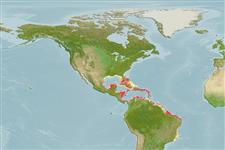Common names from other countries
Classification / Names / Names
आम नाम | उपशब्द | Catalog of Fishes (gen., sp.) | ITIS | CoL | WoRMS
Environment: milieu / climate zone / depth range / distribution range
पारिस्थितिकी
. Tropical
Western Atlantic.
Length at first maturity / आकार / वज़न / Age
Maturity: Lm ? range ? - ? cmCommon length : 9.8 cm TL पुल्लिंग / अलिंग; (Ref. 344)
Shell subcircular, heavy, inequivalve. Shell surface smooth except for fine, irregular growth lines. Hinge well developed, with posterior lateral tooth long and strong. Pallial sinus large, well developed. Umbones at central part of dorsal region. Oblique ridge runs from umbo to middle of posterior margin. Posterior shell margin sinuous in posterior view: posterior margin of right valve concave and of left valve concave. Colour: externally white, internally glossier white with yellow tinges.
In shallow water, deeply burrowing in intertidal sand near seagrass beds (Ref. 344).
Life cycle and mating behavior
परिपक्व अवधि | पुनरुत्पत्ति | मछलीऔ का अंडे देना | अंडे | Fecundity | लार्वा
Members of the class Bivalvia are mostly gonochoric, some are protandric hermaphrodites. Life cycle: Embryos develop into free-swimming trocophore larvae, succeeded by the bivalve veliger, resembling a miniature clam.
Leal, J.H. 2003. (Ref. 344)
IUCN Red List Status (Ref. 130435)
CITES status (Ref. 108899)
Not Evaluated
Not Evaluated
Human uses
मात्स्यिकी: व्यापारिक
| FishSource |
साधन
इंटरनेट स्रोत
Estimates based on models
Price category
Unknown.
